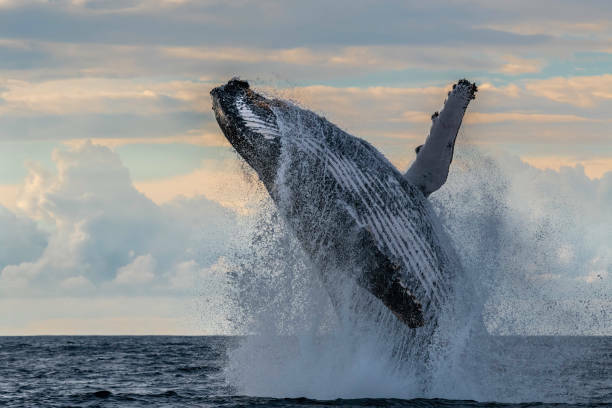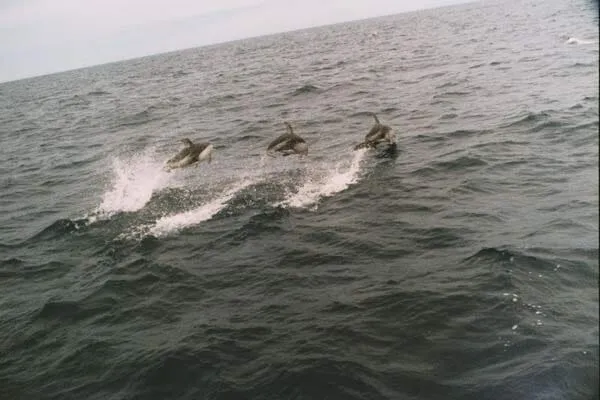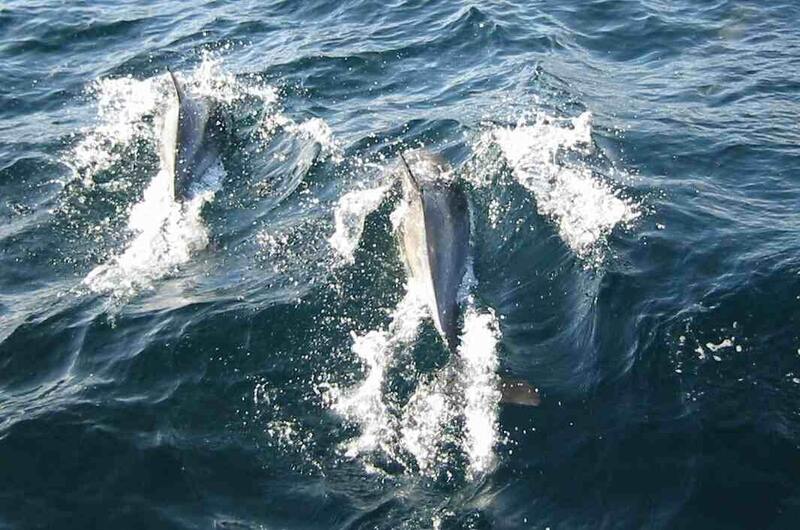Whale Watching
Whale Watching

We live in a unique part of the world where Mother Nature provides us with abundant bird and sea life. From the F/V Riptide, you can watch Whales and Sea Otters and observe the many and varied forms of bird life that both live here and migrate through our part of the Pacific. Call and we will help you design your own nature trip.
You can experience the awesome, big, and exciting fun of whales and the ocean's natural splendor aboard the Riptide!
Breaching is what whales do when they shoot out of the water like a rocket and then fall back into the ocean with a big splash. This may be done for a variety of reasons. Perhaps it is a signal to other whales; perhaps it is playful, perhaps it is to shake off small sea animals. Whales have barnacles attached to them that cannot be shaken off so easily.
Along the San Mateo Coast, we primarily see the Gray whale and the Humpback whale. Gray whales can grow to a very large size with males averaging 40 ft. and females 42 ft. The Gray whale is generally dark gray in color with mottling patterns of white patches that are used by scientists to identify individual animals. The Gray Whale migrates along our coastline each year between Baja California and the Arctic. This migration places the Gray whale in our area usually between December through March.
Humpback whales have very long flippers. Males average 48 ft. in length and females are usually somewhat longer. Humpbacks are almost black in color with white along their flippers and undersides. The tail flukes have their own unique pattern of white. Humpbacks swim in pods of three or four as they migrate. In recent years, Humpback whales have been seen with greater frequency in our area. It is believed that some of the Humpback Whales are making this area a semi-permanent home which enhances the possibility of observing the Humpback Whale during your whale watching adventure.
Dolphins are sometimes seen swimming with the whales, and are are the smallest of the Cetaceans. Dolphins are very playful and they like to swim near boats riding in the wave that the boat makes.
If you want to get up close and personal with some of our famous California Sea Lions, we can also get you there.
Whale Watching Prices and Trip Information

Trip information
- 3 hour tours leave at 9:00 A.M. & 1:00 P.M.
Prices
- $65 cash/$67 card Regular 3-hour tour
- Individuals and small groups welcome
Private Charters for Whale Watching/Nature Trips
- Weekdays - up to 12 people - $ 780 cash (Regular 3-hour tour)
- (High season possible 4-hour trips)
- Weekends - up to 15 people - $975 (Regular 3-hour tour)
- (High Season possible 4-hour trips)
- Individuals and small groups must total a minimum of 8 passengers to run a trip
Whale Watching All Day Trips::
- $100 (cash) per person Weekdays
- $100 (cash) per person Weekends
- Minimum of 10 people required for open loads.
- Private Charters for Whale Watching/Nature Trips
- Weekdays - up to 12 people - $1200 cash (Regular all day tour)
- Weekends - up to 15 people - $1500 cash (Regular all day tour)
Captain Smitty's Notebook

We thought you might like some general information and vocabulary about the animals and birds you'll see during a nature trip aboard the Riptide, so we've taken some comments from the Captain's own notebook for you to review. Watch this page for future links to other information that will enhance your trip aboard the Riptide.
GRAY WHALES: Migrate through the bay area from around Christmas through may.
HUMPBACK WHALES: Present off the shore of the bay area all year around.
BLUE WHALES: Generally present offshore and we encounter them from early summer through fall
Whales are Mammals
Some of the marine mammals in our local habitat are sea otters, whales, dolphins, and sea lions. The San Mateo coast is a special place to be able to view these animals in their natural habitat.
Although whales appear to look like fish, they are actually mammals. Whales are members of the scientific order of Cetacea and live in social groups. Distinguishing features of the order Cetacea (including whales, dolphins and porpoises) are two front flippers and uniquely shaped tails with horizontal extensions, called flukes. It is this tail that provides the necessary power for these large animals to be able to swim so gracefully.
Within the order Cetacea there are two suborders. The Odontoceti are toothed whales and this suborder includes dolphins, porpoises, the sperm whale, orca, narwhal, and beluga whales. These whales have teeth and breathe through a single blowhole. The second suborder, Mysticeti are baleen whales and includes the blue, gray, and humpback whales (as well as others not found along our coast). The baleen whale does not have teeth, instead they have rows of baleen throat pleats in the upper jaw which function to filter out and trap food. Baleen whales breathe through a pair of blowholes.
Like other mammals, whales are warm-blooded, nurse their young, and breathe air through their lungs. It is this need to come to the surface to breathe that affords us the opportunity to observe them. The whale has a "blowhole" located on the top of its head. This is similar to the human nostril and this is how the whale inhales and exhales air. Baby whales are borne underwater. The mother pushes the baby up to the surface right away so that the baby can get the first breath of air. There are more than 75 different kinds of whales. The mightiest is the Blue Whale. It is believed that this is the largest animal to ever live on earth – bigger even than the dinosaur. There are occasional sightings of a Blue Whale along our coastline.
Breaching is what whales do when they shoot out of the water like a rocket and then fall back into the ocean with a big splash. This may be done for a variety of reasons. Perhaps it is a signal to other whales; perhaps it is playful, perhaps it is to shake off small sea animals. Whales have barnacles attached to them that cannot be shaken off so easily.
The fluke is the end portion of the whale's tail. The Humpback Whale's fluke has unique patterns that serve as identifiers of individual animals similar to a fingerprint in a human being.
Spyhopping is what a whale does by poking its head out of the water. Maybe they do this to see what is happening out of the water or to see what boats are in the area today!
How do whales communicate? It is believed that whales use a series of squeaks, clicks, and whistles. You can buy recordings of whale sounds that are called "songs". Scientific research continues to explore the way and why of how whales communicate.

